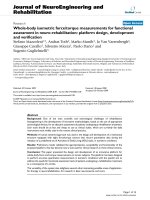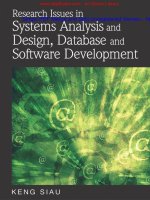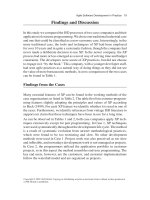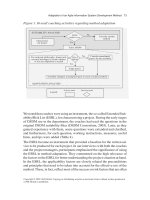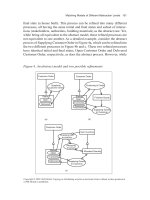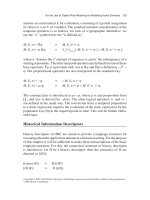C-Course Design, Development and Approval
Bạn đang xem bản rút gọn của tài liệu. Xem và tải ngay bản đầy đủ của tài liệu tại đây (583.11 KB, 38 trang )
Student Learning & Experience Committee
Chapter C:
Course Design, Development and
Approval of Teesside University Taught
Provision Including Collaborative
Provision
Document Owner:
Version number:
Effective date:
Date of next review:
Academic Registry
2.0
November 2020 (Academic Year 2020-21)
July 2021
This document is part of the University Quality Framework, which
governs the University’s academic provision.
CONTENTS
PREFACE 1
1.
INTRODUCTION 2
2.
NEW COURSE APPROVAL 3
2.1
The Course Lifecycle
3
2.2
Course Approval and Review Schedule 3
2.3
Course Approval Planning 4
DIAGRAM 1: COMMON STAGES FOR ALL COURSE PROPOSALS AND
APPROVAL PROCESSES AT A GLANCE: 5
3.
GUIDANCE ON COURSE DESIGN AND DEVELOPMENT
6
3.1
Future Facing Learning (FFL)
6
3.2
Academic Enhancement Framework (AEF) 7
3.3
A Course-First Approach
3.4
The Curriculum Road Map 7
3.5
Supporting a Course-First Approach: Stakeholders - Roles and
Responsibilities
8
3.6
Role of Students in the Course Design and Development
7
10
FIGURE 1: COURSE-FIRST APPROACH TO COURSE DESIGN AND
DEVELOPMENT 12
FIGURE 2: EMBEDDING QAA GUIDING PRINCIPLES AND UNIVERSITY
STRATEGIES INTO COURSE DESIGN AND DEVELOPMENT 13
4.
5.
3.7
Embedding University Strategies
3.8
Guidance for Course Teams
3.9
Use of Variance in Course Design and Development
14
3.10
Courses Utilising a Non-Standard Number of Credits
15
3.11
Developing an Additional Pathway(s) within an existing Teesside
University Award 15
3.12
Award Naming Conventions
3.13
Course Design Event – Digital Empowerment
CHOICE OF VALIDATION ROUTE
14
14
15
16
17
4.1
Risk Based Approach to Validation 17
4.1.1
High Risk Activity
4.1.2
Medium Risk Activity
4.1.3
Low Risk Activity
18
4.2
Mitigation of Risk
19
18
18
PLANNING THE COURSE APPROVAL EVENT 20
i
Quality Framework Chapter C - Course Design
6.
7.
5.1
Approval of Panel Members
20
5.2
Standard Course Approval Event Panel Constitution 20
5.3
Professional, Statutory and Regulatory Bodies 21
5.4
Panel Constitution for an Abridged Course Approval Panel, the
Quality Assurance Authorisation Panel (Low risk only) 21
5.5
Criteria for Internal and External School Chairing of Course
Approval 22
5.6
Appointment and Training of Validation Event Chairs and Panel
Members 22
5.7
Selection Criteria of External Panel Members – Externality
5.8
UK Home Office Visas & Immigration (UKVI) Requirement for
External Panel Members 23
5.9.
Course Approval Event Documentation 23
5.10
Supporting Course Approval Evidence File 25
23
COURSE FIRST CRITICAL READ EVENT OF THE COURSE APPROVAL
PROCESS 26
6.1
Course First Critical Read Event
26
6.1.1
Provisional Approval of the Module Diet 26
6.2
Course First Critical Read Event Panel Constitution 27
COURSE APPROVAL – GUIDANCE AND PROTOCOL OF THE APPROVAL
EVENT 28
7.1
Panel Member Guidance
28
7.2
Course Team Presentation 28
7.3
Course(s) to be delivered by Online Learning (OL) 28
7.4
Private Meetings during the Panel Event
29
7.5
Outcomes of the Course Validation Event
29
7.6
Conclusion - Date of Periodic Review or Interim Review, Modes of
Delivery, Number of Intakes and Location 31
7.7
Post Course Approval Event
7.8
Conclusion Course Validation Event Report 31
7.9
Conclusion and Sign-Off Process for Approval of Course(s) Event
31
31
ii
Quality Framework Chapter C - Course Design
GLOSSARY OF ABBREVIATIONS
AEF
Academic Enhancement Framework
AFP
Assessment and Feedback Policy
AREG (APR)
Academic Registry (Academic Policy and Regulation)
AREG (LTE)
Academic Registry (Learning and Teaching Enhancement)
AREG (QAV)
Academic Registry (Quality Assurance and Validation)
AR
Academic Registrar
AWMF
Academic Workload Management Framework
CAD
Course Approval Document
CAMS
Credit Accumulation & Modular Scheme
CDE
Course Design Event
CME
Continuous Monitoring and Enhancement
DAE
Department of Academic Enterprise
ESFA
Education and Skills Funding Agency
EPA
End Point Assessment
FCD
Finance & Commercial Development
FFL
Future Facing Learning
FHEQ
Framework for Higher Education Qualifications
HDAs
Higher and Degree Apprenticeships
HEI
Higher Education Institute
HOD
Head of Department
IfATE
Institute for Apprenticeships and Technical Education
KSBs
Knowledge, Skills & Behaviours
LEO
Longitudinal Education Outcomes
LTAS
Learning Teaching Assessment Strategy
LTSP
Learning and Teaching Strategic Plan
MVF
Module Verification Form
NSS
National Student Survey
OL
Online Learning
OfS
Office for Students
PD
Portfolio Development
iii
Quality Framework Chapter C - Course Design
PL
Principal Lecturer
PSRB
Professional, Statutory and Regulatory Body
QAA
Quality Assurance Agency
QAAP
Quality Assurance Authorisation Panel
RLO
Reading Lists Online
RPL
Recognition of Prior Learning
SAPs
Standard Administration Procedures
SLEC
Student Learning & Experience Committee
SSLESC
School Student Learning & Experience Sub-Committee
SL
Senior Lecturer
SLS
Student & Library Services
SRM
Student Recruitment and Marketing
TNE
Transnational Education
TU
Teesside University
UCs
University Certificates
UDL
Universal Design for Learning
UKVI
UK Home Office Visas & Immigration
iv
Quality Framework Chapter C - Course Design
PREFACE
The guidance contained in this document provides detailed information about the
University’s processes and requirements in relation to Course Design, Development
and Approval (validation) of new academic courses both on and off-campus,
including collaborative provision.
Excellence in learning and teaching at Teesside University is defined and
empowered through Future Facing Learning (FFL) and driven by the Learning and
Teaching Strategic Plan (LTSP). Through the strategic alignment of academic
practice and enabling infrastructure, FFL generated an unprecedented step change
to our institutional approach to the enhancement of learning and teaching, and forms
the foundation of impactful curriculum development and design. The Academic
Enhancement Framework (AEF) provides a mechanism through which Course
Teams can engage meaningfully with Future Facing Learning and other key strategic
themes relating to the student experience.
There are two routes to validation, these are as follows:
ROUTE A:
The standard, normal process for
a new course (award) which is
considered by a convened
Validation Panel and Event
OR
ROUTE B:
Undertaken, by negotiation, with
Academic Registry following an
assessment of risk an accelerated
fast-track route is followed.
Collaborative Arrangements
Awards to be considered for Collaborative delivery with existing collaborative
partners, both Route A or Route B can be considered as required, to manage,
mitigate or monitor the risk associated with the course proposal.
1
Quality Framework Chapter C
1. INTRODUCTION
The purpose of the Course Design, Development and Approval (validation)
process is to establish that all new taught courses are academically
sustainable, that academic standards are clearly defined to ensure courses
deliver a high quality student experience and offers students the best
opportunity to learn, develop and succeed regardless of the delivery
location.
The University adheres to the guiding principles for Course Design and
Development from the QAA UK Quality Code for Higher Education
(November 2018). They provide a concise expression of the fundamental
practices of the higher education sector, based on the experience of a wide
range of providers.
Teesside University has established flexible quality processes to manage
the validation, review and modification of courses and modules. The
approach within the Quality Framework can be delivered through an inperson, virtual meeting or desk-based process. Stakeholders may also be
eligible to submit written comments for consideration, as appropriate.
The University is committed to internal and external peer consultation,
involvement of Professional, Statutory and Regulatory Bodies (PSRBs), and
the national regulatory requirements specified by the OfS for maintaining
quality and standards, and those set out in the Quality Assurance Agency
(QAA) Quality Code for Higher Education.
The guidance contained in this document sets out the Course Design,
Development and validation procedures for:
Standard Route A and
Route B provision.
The underpinning guidance and procedures supporting the delivery of these
routes are provided in Appendices for those directly engaged with this
activity. The administrative details supporting the new course approval
process is available from Academic Registry (QAV).
2
Quality Framework Chapter C
2. NEW COURSE APPROVAL
2.1 The Course Lifecycle
The University undertakes the following stages to approve, monitor and
review courses:
Stage 1 The Planning Cycle which annually reviews the academic
portfolio of provision through School Annual Plans.
Stage 2 Portfolio Development (PD)/Business Case and Course Costing:
the title approval of new title(s), in principle.
Stage 3 The Course Approval Event, which is the responsibility of the
Student Learning & Experience Committee (SLEC).
Stage 4 Continuous Monitoring and Enhancement (CME) of courses,
including course modifications.
Stage 5 Course Review normally undertaken on a periodic 6-yearly cycle
(PR).
The key components covered by this guidance for Course Design,
Development and Approval relate to Stage 3 of the course lifecycle above,
which are:
The design of new courses.
The approval procedures (validation) for new courses.
As the procedures for the validation of new Course Design, Development
and Approval are similar for on and off campus, including collaborative
provision, these are addressed together. Where differences in aspects of
the process occur, this is clearly identified and differentiated.
The processes identified in this document apply to all University-based
taught awards that are credit bearing. For Postgraduate Certificates and
University Certificate Awards (UCs) please refer to the separate guide on
Short Awards or Chapter E if the short award involves a collaborative
partner.
2.2 Course Approval and Review Schedule
Following the approval (Stage 2 of the course lifecycle above), in principle,
of the business case/new title(s) through the portfolio development process,
new course proposals will be notified to Academic Registry (Quality
Assurance and Validation) (AREG (QAV)) and included in the Annual
Approval and Review Schedule and Record of Decisions List on behalf of
SLEC.
3
Quality Framework Chapter C
AREG (QAV) manage the Validation Schedule. Event dates will be agreed
through negotiation between the School (or lead School in the case of joint
delivered courses), Collaborative Partner and AREG (QAV).
Following Approval, all courses will normally be subject to review following a
6-yearly cycle. Courses due for periodic review will be automatically
included in the Validation Schedule.
Note: It is permissible for Schools and Course Teams to bring periodic
review of courses forward for a variety of purposes
2.3 Course Approval Planning
Once title approval has been granted, the Course Approval involves the
following phases:
Planning the validation event – including the development of the
Course Pre-Approval Agreement – (C-SAPs- Annex 1)
Organising the Course Approval Event and defining the
documentation, panel requirements and deadlines for meeting
documentation requirements
For Collaborative Partners the course approval location will be
determined by AREG (QAV) in conjunction with the School and
Collaborative Partner. A Link Tutor will be assigned to work with
collaborative colleagues to support the course approval process
Arranging the dates for the Course Design Event (CDE)
School and or collaborative process for reviewing documentation
[Course First Critical Read Event] including the Provisional
Approval of the Diet of Modules – see Section 6 below.
Validation Event (undertaken on behalf of the Student Learning and
Experience Committee (SLEC))
School and Academic Registry Officer led quality check of the
validation event report for accuracy and completeness
Chair of the Validation Event to review final Course documentation
and confirm amendments have been made as appropriate.
Confirmation of approval of the validation event report by the
Academic Registrar (AR) or nominee on behalf of the SLEC. List of
approvals provided to SLEC for information) – see Section 7.9
below.
Diagram 1 provides an outline of the key elements involved in the process
and those involved.
4
Quality Framework Chapter C
DIAGRAM 1: COMMON STAGES FOR ALL COURSE PROPOSALS AND
APPROVAL PROCESSES AT A GLANCE:
Course Proposals
Course proposals secure Strategic Portfolio Development (PD)/Business Case/Course Costing sign off
approval in principle.
Planning Meeting
AREG (QAV) arranges a planning meeting with the Course Leader/School and Collaborative Partner at
which the Validation Route is selected.
School /Collaborative Partner identifies Course Team CPD training needs.
AREG (QAV) arranges administrative set-up and validation Panel constitution.
AREG (QAV) confirms
Definitive documentation requirements for Route A or Route B validation event via the course
pre-approval agreement.
Publication of development calendar (timescale) leading to the validation event.
AREG (QAV) staff and central department support for course development/writing day(s) is
confirmed.
School/Course Team nominations for External Panel members.
Consultation with Stakeholders
Proposing Course Team consults and capture the views of the following for proposed new or
modified courses:
►Employers
►PSRB
►Students and Alumni
►Internal and external specialists (including those at collaborative partner providers).
Course Design Event (CDE)
Proposing Course Team is supported to develop a high impact curriculum, aligned with Future
Facing Learning and supported by the Academic Enhancement Framework.
Confirmation of MVFs
Course Leader/PL Programmes/Resources meeting with Central Timetabling to confirm MVFs.
Course First Critical Read Event Stage
School/Course Team submits draft course documentation to AREG (QAV) (2 week/s before) for
the Course First Critical Read event stage date.
AREG (QAV) produce record of outcomes and follow up actions and amendments required to
documentation.
School confirm Course Documentation updated from Course First Critical Read
Proposing Course Team proof read, check documentation and confirm its readiness for submission (2
weeks prior) to the Course Validation Event.
Course and Diet Validation Event
AREG (QAV) communicates agenda and panel constitution.
AREG (QAV) Officer produces draft validation conditions and event report with deadline for meeting
conditions and School/Collaborative Partner sign-off.
Sign-off
AR/nominee on behalf of the Student Learning & Experience Committee (SLEC).
AREG (QAV) submits list of validation report to SLEC for information.
AREG (QAV) confirms course approval to School, Finance & Commercial Development (FCD) and
Student Recruitment & Marketing (SRM).
►Subject to Approval (STA) flag removed.
5
Quality Framework Chapter C
3.
GUIDANCE ON COURSE DESIGN AND DEVELOPMENT
3.1 Future Facing Learning (FFL)
Future Facing Learning is the distinctive pedagogic approach adopted by
Teesside University. Future Facing Learning provides students with the
skills, knowledge and tools to thrive in complex and uncertain futures, and
achieve sustainable success within the global workplace.
Future Facing Learning consists of the following core themes:
RESEARCH ACTIVE: Our students encounter the grand challenges of
our time through research and professional practice.
FUTURE READY: High quality, future ready graduates are developed
through our commitment to industry relevance and entrepreneurship.
GLOBALLY CONNECTED: Our students are globally connected through
an internationalised curriculum and learning experience.
SOCIALLY AND ETHICALLY ENGAGED: Our students engage
meaningfully with social and ethical issues from local, national and
international perspectives.
DIGITALLY EMPOWERED: Our students are digitally empowered with
the skills and tools to deliver global impact.
6
Quality Framework Chapter C
3.2 Academic Enhancement Framework (AEF)
The Academic Enhancement Framework (AEF) provides the
structure through which Future Facing Learning, and other key
strategic priorities, are embedded within academic practice. The AEF
consists of the following themes:
1.
2.
3.
4.
5.
6.
7.
8.
9.
Research Active
Future Ready
Globally Connected
Socially and Ethically Engaged
Digitally Empowered
Student Voice
Student Success
Transitions
Wellbeing
Each theme is the subject of an AEF matrix which provides a set of key
principles and outlines the trajectory from expectation through to excellence.
3.3 A Course-First Approach
The University advocates a Course-First Approach to the design and
development of curricula. The approach places emphasis on the overall
coherence and connectedness of learning outcomes and learning, teaching
and assessment practices at the scale of the course. Such a course-focused
view helps to frame curriculum and assessment design to fully consider the
learning journey and experience of the student. There are three core
considerations:
A
B
C
Approach(es): Learning, teaching and assessment approaches
and methods selected for best fit with course learning outcomes,
including knowledge/skills development and learner autonomy.
Balance: Course diet includes a variety of modes and methods
of learning, teaching and assessment, providing an appropriate
mix of formative and summative activities, paying particular
attention to the quantity and timing of assessment to promote
student learning development.
Coherence: Alignment of assessment, learning outcomes and
teaching and learning activities is established and clearly
communicated. Learning and teaching practices are consistent
across levels of study and assessment and feedback processes
are designed to create connectivity between modules and tasks
across and along the entire course (vertically and horizontally).
3.4 The Curriculum Road Map
The curriculum roadmap is designed to facilitate and support a coursefocused approach to curriculum design and development, refer to C:
7
Quality Framework Chapter C
Appendix 2 Guidance for Course Teams for the Validation of New and
Periodic Review of Courses, Including Collaborative Provision.
As stated above the course-focused approach places emphasis on the
overall coherence and connectedness of learning outcomes and learning,
teaching and assessment practices at the scale of the course. It requires a
strategic, collaborative and planned approach by Course Teams to ‘design in’
how the elements that make up the student learning and assessment
experience support each other and are structured to help guide students’
progression towards attainment of course learning outcomes.
3.5
Supporting a Course-First Approach: Stakeholders - Roles and
Responsibilities
The roles and responsibilities of key members of staff involved in the
process of developing new awards/courses are as follows:
Stakeholders
School Strategic Management
Team
Head of Department (HOD)
PL Learning and Teaching/PL
Programmes
Subject Course Team
Collaborative Partners
Role and responsibility
with responsibility for shaping and defining
the School curriculum portfolio offer;
communicating the offer and timeframe for
new curriculum development and review.
has responsibility for leading, resourcing
and supporting the subject Course Team
to deliver the development of new
curricular.
with responsibility to support the Course
Team in embedding good learning and
teaching practices, meeting
documentation requirements and
timetabling e.g. Module Verification Forms
(MVF)/UTREG.
has responsibility for ensuring the
curricular development and design of
awards are carried out in a timely manner,
and in line with University guidance for the
approval of courses, engaging with
appropriate internal academic regulations,
good practice guides and external
reference sources.
working with the assigned Link Tutor who
has responsibility for supporting the
collaborative Course Team to ensure new
courses are designed and approved in
accordance with University practices and
processes.
8
Quality Framework Chapter C
Supplementary members supporting the development and design of
new courses are:
Stakeholders
Academic Registry (Quality
Assurance and Validation)
Academic Registry (Learning
and Teaching Enhancement)
Academic Registry (Academic
Policy and Regulations)
Central Timetabling (only
applicable to TU awards
delivered on main campus and
Darlington Campus)
Department of Academic
Enterprise (DAE)
Finance and Commercial
Development (FCD)
Role and responsibility
will work closely with the School and
Course Team where appropriate
providing administrative support, for
instance, from access and uploading of
module templates, the allocation of
external panel members to preparation
and support for the Course First Critical
Read Event Stage of the validation
process in a timely manner.
can provide the Course Team with expert
advice and support on embedding the
Curriculum Road Map, digital technology
(digital learning developers), developing
on-line provision and applying Universal
Design for Learning Principles (UDL) to
inclusive learning practices to module
learning, teaching and assessment
design and delivery. Additional guidance
is available in a set of guides to help
support staff in their learning and
teaching role. The series of booklets are
available on the LTE Online website.
For online learning courses, each
course will be assigned an Online
Learning Designer who will co-create the
development of all documentation
specific to OL courses.
will work with School and Course Team
where appropriate, to provide advice and
guidance on the application of
assessment regulations (u/g, p/g,
variance).
will support and advise Course
Teams/Module Leaders on the
preparation/completion of the course(s)
timetable/MVF for the Course First
Critical Read Event Stage.
The Student Futures Service (TU
provision only) can support the Course
Team with market intelligence on careers,
labour market analysis from EMSI and
meeting Future Ready graduate
expectations.
can support the School/Course Team
with producing the Course Costing
9
Quality Framework Chapter C
Student and Library Services
(SLS)
Student Recruitment and
Marketing (SRM)
Students Union
template required for the development of
all new courses.
Disability Services, can support the
Course Team, and as a minimum, should
be consulted on providing expert advice
on developing inclusive and alternative
assessment strategy i.e. teaching
methods and assessments for students
with disabilities via the School Disability
Co-ordinator.
The Academic Librarian can help to
integrate process and personal skills
development into curricular content,
preparing indicative resource Reading
Lists Online (RLO) and embedding
academic skills at various levels of the
course.
will provide the market intelligence to
support the business case of course
approval and the publication of marketing
material
can support Course Teams to facilitate
the student voice and in co-creation of
curricula.
3.6 Role of Students in the Course Design and Development
A key principle of course approval activity is the engagement of students.
Under the QAA revised Quality Code, student engagement is listed within
core and common practices.
Under core practices, it states:
‘The provider actively engages students, individually and collectively, in
the quality of their education experience.’
While the following is a common practice in the Code:
‘The provider engages students individually and collectively in the
development, assurance and enhancement of their educational
experience.’
The Student Voice forms a core theme of the Academic Enhancement
Framework.
Therefore, the Course Approval Document (CAD) is expected to incorporate
feedback and evidence from students on the design/co-design and
development of the course(s). Existing and former students (alumni) should
also be consulted, where available via focus groups or on-line mechanisms
10
Quality Framework Chapter C
etc. Consultation with current students can be facilitated via the Student
Representative Scheme.
Figure 1 provides an overview of the course design and development
phases which Course Teams are expected to engage with.
Figure 2 provides an overview of how course design and development
enable the embedding of the QAA key guiding principles and
University strategy through the Curriculum Road Map
11
Quality Framework Chapter C
FIGURE 1: COURSE-FIRST APPROACH TO COURSE DESIGN AND DEVELOPMENT
12
Quality Framework Chapter C
FIGURE 2: EMBEDDING QAA GUIDING PRINCIPLES AND UNIVERSITY STRATEGIES INTO COURSE DESIGN AND
DEVELOPMENT
13
Quality Framework Chapter C
As Figure 2 illustrates, externally courses must comply with the Quality
Assurance Agency (QAA) Quality Code, to meet the Framework for
Higher Education Qualifications (FHEQ) levels of study, incorporate relevant
qualification characteristics, subject benchmarks and satisfy any
Professional, Statutory and Regulatory Body (PSRB) requirements.
3.7 Embedding University Strategies
Internally, every course must reflect the key features of the University
Strategies, which are as follows:
Teesside 2020
Learning and Teaching Strategic Plan
Enterprise and Business Engagement Strategic Plan
Research Strategy and Policy
International Strategic Plan
Placement and Internship Policy and Procedure
Module digital toolkit, to support the digital strategy
The following internal academic frameworks should be consulted:
Credit Accumulation & Module Scheme (CAMS)
Assessment and Feedback Policy (AFP)
Assessment Regulations (undergraduate/post-graduate)
Credit Level Descriptors, utilising the Generic Marking Criteria (see
Assessment and Feedback Policy) and
Teesside University Dual Awards Framework (where applicable).
3.8 Guidance for Course Teams
Course Teams will need to refer to the Guidance for Course Teams for the
Validation of New and Periodic Review of Courses, Including
Collaborative Provision (see C-Appendix 2) when developing courses/or
when employing existing awards to offer courses to specific markets e.g.
Accelerated Degrees, HDAs L4-L7. Exemplar documentation to assist
Course Teams are available from AREG (QAV).
Module Guidance is available to support the initial design, approval and
ongoing review. This includes specific guidance in relation to the
Assessment Regulations (2014), and implications for learning and teaching,
and assessment design. This guidance is contained within the Good
Practice Guide for Module Leaders on Module Design and
Development (C-Appendix 3).
3.9 Use of Variance in Course Design and Development
The University operates Institution-wide Assessment Regulations to
ensure professional academic judgement about standards and
performance are exercised in such a way that all students are treated
14
Quality Framework Chapter C
fairly, comparatively, and with consistency regardless of School,
Institution, subject or course.
However, it is recognised that occasionally, and under specific conditions,
some variance to the Regulations may be necessary. Any such variance will
be exceptional and must be fully justified to, and approved by, SLEC.
Variance to the Regulations will normally only be approved to meet the
specified requirements or expectations of PSRBs or other such external
bodies that accredit awards of the University.
Further guidance can be found on the Variance Procedure for
Assessment Regulations website or consult directly with colleagues in
AREG (APR).
3.10
Courses Utilising a Non-Standard Number of Credits
The standard number of credits and levels are defined in CAMS e.g. 120 L4,
120 L5 and 120 L6 for a standard undergraduate course. However, these
describe the minimum requirements.
Where a course is proposed that exceeds these standards and there are
possible implications in relation to the assessment and progression
regulations, further guidance should be sought from the AREG (APR) Team.
In addition, all modules should have a mark or grade attached to enable
classification/grading to be calculated. Where this is not the case, again
guidance should be sought from the AREG (APR) Team.
3.11
Developing an Additional Pathway(s) within an existing Teesside
University Award
The term ‘pathway’ and or ‘route’ are used interchangeably to describe a
designated pathway/route through the available modules on a course which
implies a specialism, which may or may not be reflected in the award title.
Academic courses may therefore, include within them a number of
"pathways" which provide students with the opportunity to focus their studies
more directly towards one particular aspect/area of the academic discipline
being studied.
If appropriate, the name of a particular pathway can be reflected in the award
title as either the full title of the award or as a "bracketed extension" to the
overall award title. In either case, the use of the pathway title in the title of the
award must be approved as part of the title approval process for the award
(CAMS 4.6.2).
3.12
Award Naming Conventions
Under the University convention of Naming Awards in the Quality
Framework Chapter B: Portfolio Development (B-Annex 10 ‘Alternative
Award Titles for Similar Programmes of Study’), the following guidance
15
Quality Framework Chapter C
should be observed by the School and Course Team when seeking the
validation of an additional pathway:
3.13
It should always be possible to articulate clearly, why one award title is
different from another when the content of the awards is very similar or
even identical. One of the legitimate reasons might be to improve the
marketability of the award in recruitment.
The above criteria are based on academic judgement and should
outweigh any mechanistic considerations. However, as a guide 60
credits would normally be a reasonable amount of differentiation on a
360 credit undergraduate course, with pro rata differentiation in other
awards of 60 credits or more. Approval Panels will need to exercise
discretion in the case of awards of less than 60 credits.
All additional pathway award titles (including named intermediate (fallback awards) should have their own course specification. There should
be an additional course specification for an alternative award title, even
when the modular course is the same.
Course Design Event – Digital Empowerment
The second part of the CDE process, integral to Course Design, is a focus
on Digital Empowerment of learners incorporating digital tools and platforms
with the aim of delivering a seamless ecosystem for learning. Further
information and guidance is available to course and module leaders within
C-Appendix 3 - Good Practice Guide for Module Leaders on Module
Design and Development.
16
Quality Framework Chapter C
4. CHOICE OF VALIDATION ROUTE
There are 2 possible processes to validation:
ROUTE A:
The standard, normal route which is an iterative process of course
development over a standard time period (6+ months) and normally
applies to the following course developments
New course approval (including those with collaborative partners,
major/minor awards)
Dual/Joint Awards
New Course in a non-congruent subject area.
ROUTE B:
Accelerated (fast-track) path, which is undertaken by negotiation and will
be decided on an assessment of risk. This course development is
normally undertaken within a 6 month timeframe and is normally to take
advantage of financial/funding/strategic imperatives or market demand.
This route is normally applied to award developments which:
Involve utilising an existing approved modules** e.g. for Online
Learning, Higher and Degree Apprenticeships (HDAs), Accelerated
Degrees.
Adding a pathway to existing provision
Top-up (L6) provision
Course developments to meet emerging disciplines or
interdisciplinary opportunities
Reaction to institutional, local or national strategies or
developments within the discipline
** Caveat: The amount and balance between utilising existing modules in
approval and development of new modules will also determine the Route
undertaken as part of the risk assessment.
4.1 Risk Based Approach to Validation
The University applies a risk-based approach to validation activity which
supplements decision making but is distinct from the process undertaken by
Route A and B described above.
17
Quality Framework Chapter C
Risk is determined/defined by the factors which can seriously impact on the
student experience and quality and standards of the awards granted by the
University. Consequently, to mitigate against the risks listed below, which
are indicative, the University has articulated the process to be followed to
ensure the level of scrutiny given to each Course Approval remains
proportionate, fair and transparent.
4.1.1
High Risk Activity
High risk activity is based on, for example, the possible associated risks
listed (indicative):
A course is in a non-congruent subject area where the School has
limited expertise;
Limited experience of one or both partners in Dual/Joint award delivery;
Resources (both physical, technical and human) may be a prohibiting
factor;
Courses in approval have given cause for concern and require review
prior to periodic review i.e. underperformance of course KPI identified
through Continuous Monitoring and Enhancement (CME).
4.1.2
Medium Risk Activity
Medium risk activity is based, for example, on the associated risks linked to:
4.1.3
Market demand and financial stability (tested at PD/Business Case
stage);
Delivery of award(s) at an additional location;
Co-delivery of an award with an existing collaborative partner i.e.
Transnational Education (TNE), Employer; (please refer to Chapter E)
Modes of delivery i.e. OL, HDAs;
Transition of students to new, existing or reviewed courses;
Resource requirements i.e. staffing, physical resources, licencing etc.
for international delivery;
Courses in approval require substantial revision in order to respond to
sector/accrediting body changes e.g. meeting HDA EPA standard.
Low Risk Activity
The University recognises that for example, short awards of less than a 120
credits, (excludes Postgraduate Certificate in Education (PgCE/PGCE)
which lead to a recognised teaching qualification) requires a different
approach from the introduction to a new subject or the approval of a course
to be delivered at/with a Collaborative Partner Institution by academic staff
not employed by the University.
As a result, the University is able to undertake a low risk approach to such
activity based on the following factors:
18
Quality Framework Chapter C
Where market and consumer demand strongly supports the
development;
Funding sources are available to support the development e.g. NHS
contracts;
Changes to modules in approval to be utilised for short awards are
considered minor in nature and process through QAAP
4.2 Mitigation of Risk
To reduce the risk factors associated with validation activity the University
has determined the level of documentation requirements, degree of scrutiny
and the panel constitution for each activity. The table below provides an
overview of the process to be followed:
Risk
Process
High
Medium
Standard Route A
Standard Route A or Route B
Quality Assurance Authorisation
Panel (QAAP)
Low
Panel
Constitution
Standard
Standard
Abridged
19
Quality Framework Chapter C

